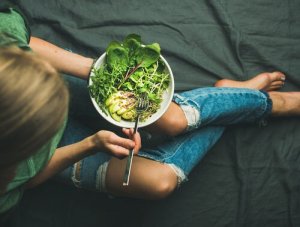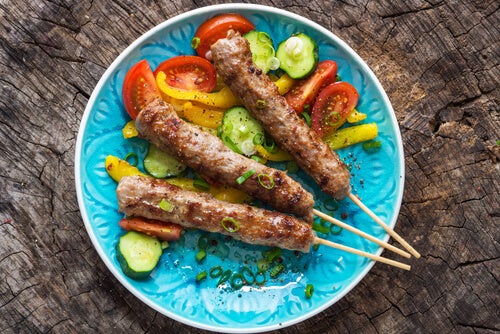Flexitarians: Flexible Vegetarians

When it’s time to eat, the options can seem endless. These days, there are more available ingredients and recipes than ever before. Deciding what to eat is a personal choice, based on likes, dislikes, and beliefs. By now, most people are familiar with vegetarian and vegan diets, but have you heard about flexitarians?
So-called “flexitarians” are becoming more and more common. The underlying motivator is people’s desire for a more environmentally sustainable lifestyle. In this article, we’ll discuss this kind of diet in detail and discover the benefits it can provide.
What do flexitarians eat?
The word flexitarian comes from the combination of the words flexible and vegetarian. The term was coined by a reporter named Linda Anthony in 1992. Years later, in 2003, the American Dialect Society chose the word as the “most useful” word of the year.
As you might have guessed, flexitarians are people who eat a semi-vegetarian diet. They focus on plant-based foods, but also eat meat occasionally.

It’s important to note that vegetarianism doesn’t allow meat consumption of any kind. However, more and more people are incorporating elements of a vegetarian diet into their otherwise carnivorous lifestyle.
Thus, do flexitarians share the vegetarian perspective on animal mistreatment? There isn’t a definite answer to that question. Some flexitarians do, some don’t. What really defines a flexitarian is their decision to live a healthy and environmentally sustainable lifestyle.
The flexitarian diet
- As its name suggests, the flexitarian diet is flexible. You can eat meat and vegetables; anything you’d like. Meat should be an occasional choice, however, to promote a healthier and more sustainable food system. Flexitarians don’t subscribe to a rigid set of rules. If someone offers them meat twice a day, for example, they can eat it.
- A vegetarian diet as the foundation. The primary food group for flexitarians is vegetables. It’s what they eat the most.
- Healthy. The flexitarian diet is balanced and healthy. Eating pasta for every meal, even if you only have meat once a week, would not be flexitarian-approved. The key is to choose foods that are good for you.
- Sustainable. Flexitarians also think about the environmental cost of food production. Consequently, foods that have a high environmental cost, such as meat or imported goods, should be enjoyed only occasionally.
The flexitarian diet is more social than a vegetarian one. Flexitarians can eat meat at social events or restaurants, for example. This makes it much easier to balance a social life and personal beliefs.
What’s the difference between flexitarians and semi-vegetarians?
If you eat vegetarian once a week, you’re not a flexitarian. Flexitarians eat vegetarian most of the time and occasionally enjoy meat.
Flexitarianism isn’t synonymous with semi-vegetarianism. The difference is that semi-vegetarians don’t eat red meat, but flexitarians do.
The key to flexitarianism is frequency. Mostly vegetarian, limited meat consumption. Ultimately, each individual will determine how much meat they eat and what kind. There are no strict rules.

Benefits of a flexitarian diet
A flexitarian diet is beneficial for many reasons:
- It can help prevent heart problems.
- A flexitarian diet is more budget-friendly.
- Eating this way can reduce your risk of developing type 2 diabetes.
- It’s more environmentally sustainable.
- It lets you enjoy all kinds of foods.
- You might live longer.
- It can help you lose weight.
- Lastly, you won’t become obsessed with dietary rules and restrictions.
A study by Abbigail B. Pace also discovered that a flexitarian diet (along with regular exercise) can reduce the risk of breast cancer, prostate cancer, and colon cancer.
These days, there are many variations on the flexitarian diet. Journalist and author Mark Bittman has one called the V6 diet, which suggests avoiding all animal products after 6:00 p.m.
Down Jackson Blatner also wrote a flexitarian cookbook, full of advice for living a healthy life through a balanced diet.
In conclusion, being a flexitarian means being a conscious eater. How much it benefits your health will depend on what exactly you decide to eat, but the idea is that you choose foods that are good for your body and good for the environment. Intrigued? Why not give it a try?
When it’s time to eat, the options can seem endless. These days, there are more available ingredients and recipes than ever before. Deciding what to eat is a personal choice, based on likes, dislikes, and beliefs. By now, most people are familiar with vegetarian and vegan diets, but have you heard about flexitarians?
So-called “flexitarians” are becoming more and more common. The underlying motivator is people’s desire for a more environmentally sustainable lifestyle. In this article, we’ll discuss this kind of diet in detail and discover the benefits it can provide.
What do flexitarians eat?
The word flexitarian comes from the combination of the words flexible and vegetarian. The term was coined by a reporter named Linda Anthony in 1992. Years later, in 2003, the American Dialect Society chose the word as the “most useful” word of the year.
As you might have guessed, flexitarians are people who eat a semi-vegetarian diet. They focus on plant-based foods, but also eat meat occasionally.

It’s important to note that vegetarianism doesn’t allow meat consumption of any kind. However, more and more people are incorporating elements of a vegetarian diet into their otherwise carnivorous lifestyle.
Thus, do flexitarians share the vegetarian perspective on animal mistreatment? There isn’t a definite answer to that question. Some flexitarians do, some don’t. What really defines a flexitarian is their decision to live a healthy and environmentally sustainable lifestyle.
The flexitarian diet
- As its name suggests, the flexitarian diet is flexible. You can eat meat and vegetables; anything you’d like. Meat should be an occasional choice, however, to promote a healthier and more sustainable food system. Flexitarians don’t subscribe to a rigid set of rules. If someone offers them meat twice a day, for example, they can eat it.
- A vegetarian diet as the foundation. The primary food group for flexitarians is vegetables. It’s what they eat the most.
- Healthy. The flexitarian diet is balanced and healthy. Eating pasta for every meal, even if you only have meat once a week, would not be flexitarian-approved. The key is to choose foods that are good for you.
- Sustainable. Flexitarians also think about the environmental cost of food production. Consequently, foods that have a high environmental cost, such as meat or imported goods, should be enjoyed only occasionally.
The flexitarian diet is more social than a vegetarian one. Flexitarians can eat meat at social events or restaurants, for example. This makes it much easier to balance a social life and personal beliefs.
What’s the difference between flexitarians and semi-vegetarians?
If you eat vegetarian once a week, you’re not a flexitarian. Flexitarians eat vegetarian most of the time and occasionally enjoy meat.
Flexitarianism isn’t synonymous with semi-vegetarianism. The difference is that semi-vegetarians don’t eat red meat, but flexitarians do.
The key to flexitarianism is frequency. Mostly vegetarian, limited meat consumption. Ultimately, each individual will determine how much meat they eat and what kind. There are no strict rules.

Benefits of a flexitarian diet
A flexitarian diet is beneficial for many reasons:
- It can help prevent heart problems.
- A flexitarian diet is more budget-friendly.
- Eating this way can reduce your risk of developing type 2 diabetes.
- It’s more environmentally sustainable.
- It lets you enjoy all kinds of foods.
- You might live longer.
- It can help you lose weight.
- Lastly, you won’t become obsessed with dietary rules and restrictions.
A study by Abbigail B. Pace also discovered that a flexitarian diet (along with regular exercise) can reduce the risk of breast cancer, prostate cancer, and colon cancer.
These days, there are many variations on the flexitarian diet. Journalist and author Mark Bittman has one called the V6 diet, which suggests avoiding all animal products after 6:00 p.m.
Down Jackson Blatner also wrote a flexitarian cookbook, full of advice for living a healthy life through a balanced diet.
In conclusion, being a flexitarian means being a conscious eater. How much it benefits your health will depend on what exactly you decide to eat, but the idea is that you choose foods that are good for your body and good for the environment. Intrigued? Why not give it a try?
All cited sources were thoroughly reviewed by our team to ensure their quality, reliability, currency, and validity. The bibliography of this article was considered reliable and of academic or scientific accuracy.
- El primer portal en español de flexitarianismo. Recuperado de: www.flexitariano.org, el 19 de Octubre de 2018.
- Every Day Health. Recuperado de: www.everydayhealth.com, el 19 de Octubre de 2018.
- Pace, A. (2016). Beneficts of a Flexitarian Diet: Educating College Students of Lifestyle Approaches to Reduce the Risk of Developing Breasr and Prostate Cancer.
This text is provided for informational purposes only and does not replace consultation with a professional. If in doubt, consult your specialist.







